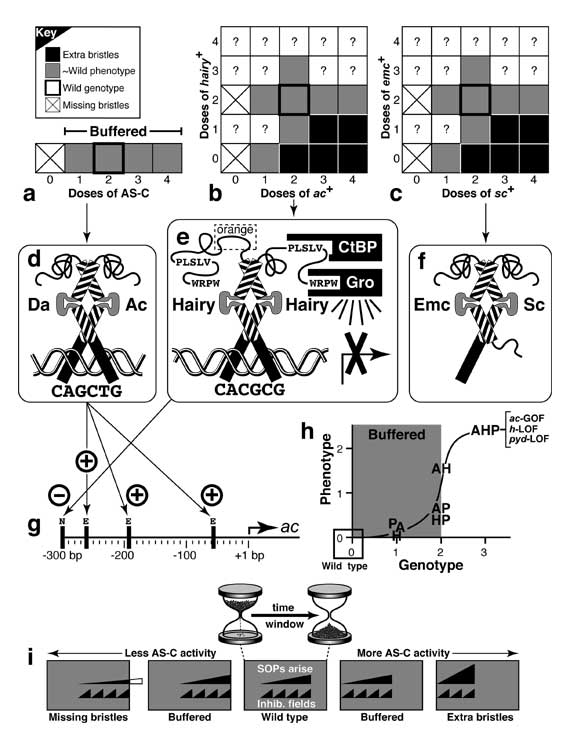Select image to enlarge

Figure 3.12
How HLH proteins 'compute' bristles.
Proneural proteins (Ac, Sc, Da) prod cells to become SOPs, while antineural proteins (Hairy, Emc) restrain them.
a-c. Dose-dependent interactions (see key), based on data from [408, 1348, 1354, 2959, 2960]. a. Wild-type females have two AS-Cs (one on each X), and 'dosage compensation' rectifies the level in males to parity by a chromatin-remodeling trick (not shown) [1633, 2183, 3760] that is poorly understood [307, 308, 3249, 3997]. The phenotype resists change when AS-C dose deviates by up to a factor of two (halved to 1 or doubled to 4), and such buffering is also seen with hairy+ (b) or emc+ (c). However, extra bristles arise when increases in Ac or Sc combine with decreases in Hairy or Emc.
d-f. HLH dimers that affect a cell's ability to become a SOP. Shading conforms to Fig. 2.4: basic region (black), helices (hatched), loop (gray), and remainder ('noodle'). d. Ac/Da (and Sc/Da) heterodimers stimulate transcription of ac by binding 'E boxes' (class A sites [1242, 3179]) in the ac promoter (g): CAGCTG (-262 and -195) or CAGGTG (-58) [2722, 4452, 4453]. They also activate sc [918] (not shown). These effects are blocked by Hairy and Emc, but in different ways. e. Hairy does not dimerize with Ac, Sc, or Da [68, 4452]. Its homodimers bind upstream of ac at CACGCG (a variant N box or class C site) and repress ac transcription (g) [3179, 4451] -- possibly via the orange domain [976], but more likely by recruiting Groucho (Gro, a long-range silencer that binds WRPW) [1242, 4524, 4865], C-terminal binding protein (CtBP, a short-range quencher that binds PLSLV) [2180, 3377, 3430], or other co-repressors such as dDrap (not shown) [3648]. f. Emc sequesters Ac, Sc, and Da in dimers that are inert because Emc lacks a basic (DNA-binding) domain [589, 3179, 4452, 4453]. As a result of this 'broken pliers' configuration, ac and sc cannot auto- and cross-activate in Emc's presence. Emc's effects in vivo may be greater on sc due to when (vs. where) emc is expressed. This disabled dimer trick is also used in the LIM-HD and POU-HD families, where Beadex [2854, 3908] and I-POU [4380] play roles analogous to that of Emc. This process whereby an inhibitor sequesters an activator is called 'squelching' [1984, 4806] to distinguish it from 'quenching' (i.e., the blocking of an activator by an inhibitor after both have bound a DNA site) [1600, 1984, 2350].
g. Promoter region upstream of the ac transcription start site (crooked arrow). E and N boxes are marked; + = activation; - = repression.
h. An example of buffering, where three mutations were studied singly or combined : acGOF (A, a.k.a. Hairy wing), hairyLOF (H), and pydLOF (P). All of them increase activity of the AS-C [635, 733, 3179, 4451]. The number of mutations per fly is along the x axis; the number of extra scutellar macrochaetes is along the y axis [3069]. Phenotypes remain nearly wild-type until the double-mutant threshold (cf. a-c) where synergism appears.
i. Time Window Model for pattern buffering. In each panel, x is time, the upper triangle denotes gradual production of SOPs in a proneural field, and lower triangles denote the time needed for SOPs to extend inhibitory fields (they are not really sequential). In wild-type flies, the time available for patterning (window width) exceeds the time needed (upper triangle width), so slight changes in AS-C activity may shift the timing of events (2nd and 4th panels), while more extreme changes (1st and 5th panels) may alter the rate of accumulation of Ac and Sc (gradient slope). High-AS-C flies should make SOPs so fast that they cannot fully extend inhibitory fields before new SOPs arise nearby (leading to extra bristles), while low-AS-C flies will make SOPs so slowly that time expires before the wild-type number is attained. Whether HLH proteins also help terminate this time window is not known, but a HLH Hourglass has been found in vertebrates [2293, 2294] that uses proneural and antineural bHLH antagonists (cf. Fig. 2.1). See also App. 7.
|
|
